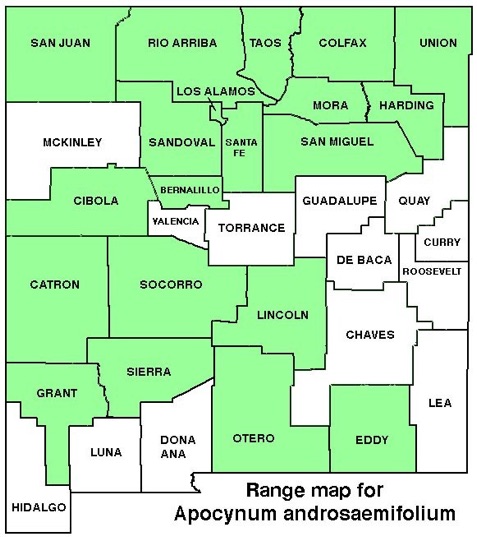WILDFLOWERS OF NEW MEXICO

Erect, stout 8–40-inch tall stems have tree-like leaves and numerous branches tipped with rounded clusters of small pinkish-white flowers. Note the milky sap (toxic) and bell-shaped flowers with petals with red strips on the inside and tips that curl backwards.
FLOWERS: June–August. Rounded clusters of slightly nodding, bell-shaped flowers 1/4–3/8-inch (6–10 mm) long with 5 petal-like lobes that curl backwards (reflexed).
LEAVES: Opposite, drooping (not ascending). Blades bright green, oval, 1 1/8–2 3/8-inches (3–6 cm) long by 3/4-1 3/8-inches (2–3.5 cm) wide, pointed at both ends, with prominent veins.
HABITAT: Moist sandy, gravelly soils, drainages, roadside ditches; pinyon-Gambel’s oak, ponderosa, aspen-fir forests.
ELEVATION: 6,000–9,200 feet.
RANGE: Widespread through western, north-central, north-eastern U. S.
SIMILAR SPECIES: Common Dogbane, A. cannabinum, in much the same range but usually lower elevations (pinyon-juniper), has erect leaves, greenish-white flowers with petal-like lobes that don’t curl back. Hybrids between the two have variable characteristics.
NM COUNTIES: Widespread in NM mountains in mid- to high-elevation habitats: Bernalillo, Catron, Cibola, Colfax, Eddy, Grant, Harding, Lincoln, Los Alamos, Mora, Otero, Rio Arriba, San Juan, San Miguel, Sandoval, Santa Fe, Sierra, Socorro, Taos, Union.

SPREADING DOGBANE
APOCYNUM ANDROSAEMIFOLIUM
Dogbane Family, Apocynaceae
Perennial herb
THE CONTENTS OF THIS WEBSITE ARE COPYRIGHTED AND CANNOT BE USED
WITHOUT PERMISSION OF GEORGE OXFORD MILLER





EMAIL ME